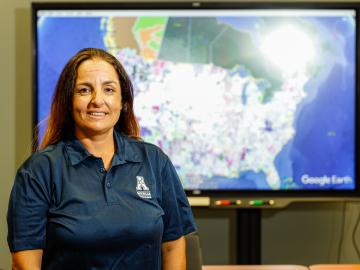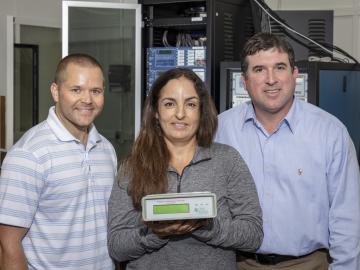
Filter News
Area of Research
- (-) Energy Science (36)
- (-) Neutron Science (6)
- (-) Nuclear Science and Technology (1)
- Biology and Environment (35)
- Biology and Soft Matter (1)
- Computational Biology (1)
- Electricity and Smart Grid (1)
- Fusion and Fission (5)
- Isotopes (2)
- Materials (12)
- Materials for Computing (1)
- National Security (16)
- Quantum information Science (1)
- Supercomputing (32)
News Topics
- (-) Artificial Intelligence (6)
- (-) Cybersecurity (5)
- (-) Grid (13)
- (-) Polymers (2)
- (-) Space Exploration (3)
- 3-D Printing/Advanced Manufacturing (26)
- Advanced Reactors (6)
- Big Data (1)
- Bioenergy (13)
- Biology (7)
- Biomedical (10)
- Biotechnology (1)
- Buildings (11)
- Chemical Sciences (5)
- Clean Water (5)
- Composites (2)
- Computer Science (14)
- Coronavirus (11)
- Energy Storage (21)
- Environment (21)
- Fossil Energy (2)
- Fusion (6)
- High-Performance Computing (3)
- Hydropower (1)
- Isotopes (2)
- Machine Learning (3)
- Materials (9)
- Materials Science (13)
- Mathematics (2)
- Mercury (1)
- Microelectronics (1)
- Microscopy (3)
- Molten Salt (1)
- Nanotechnology (4)
- National Security (2)
- Neutron Science (56)
- Nuclear Energy (19)
- Partnerships (4)
- Physics (2)
- Quantum Computing (1)
- Quantum Science (2)
- Security (4)
- Simulation (1)
- Summit (4)
- Transportation (17)
Media Contacts

Researchers at the Department of Energy’s Oak Ridge National Laboratory (ORNL) in late February demonstrated a 20-kilowatt bi-directional wireless charging system installed on a UPS medium-duty, plug-in hybrid electric delivery truck.

In the race to identify solutions to the COVID-19 pandemic, researchers at the Department of Energy’s Oak Ridge National Laboratory are joining the fight by applying expertise in computational science, advanced manufacturing, data science and neutron science.

Biological membranes, such as the “walls” of most types of living cells, primarily consist of a double layer of lipids, or “lipid bilayer,” that forms the structure, and a variety of embedded and attached proteins with highly specialized functions, including proteins that rapidly and selectively transport ions and molecules in and out of the cell.

Scientists at the Department of Energy’s Oak Ridge National Laboratory have developed a new method to peer deep into the nanostructure of biomaterials without damaging the sample. This novel technique can confirm structural features in starch, a carbohydrate important in biofuel production.

Each year, approximately 6 billion gallons of fuel are wasted as vehicles wait at stop lights or sit in dense traffic with engines idling, according to US Department of Energy estimates.

Students often participate in internships and receive formal training in their chosen career fields during college, but some pursue professional development opportunities even earlier.

A modern, healthy transportation system is vital to the nation’s economic security and the American standard of living. The U.S. Department of Energy’s Oak Ridge National Laboratory (ORNL) is engaged in a broad portfolio of scientific research for improved mobility

Isabelle Snyder calls faults as she sees them, whether it’s modeling operations for the nation’s power grid or officiating at the US Open Tennis Championships.

As Puerto Rico works to restore and modernize its power grid after last year’s devastating hurricane season, researchers at Oak Ridge National Laboratory have stepped up to provide unique analysis, sensing and modeling tools to better inform decisions.

Oak Ridge National Laboratory scientists have developed a crucial component for a new kind of low-cost stationary battery system utilizing common materials and designed for grid-scale electricity storage. Large, economical electricity storage systems can benefit the nation’s grid ...


